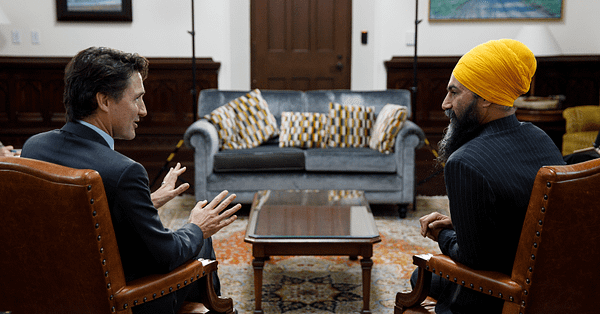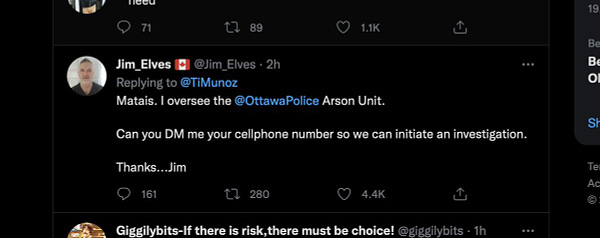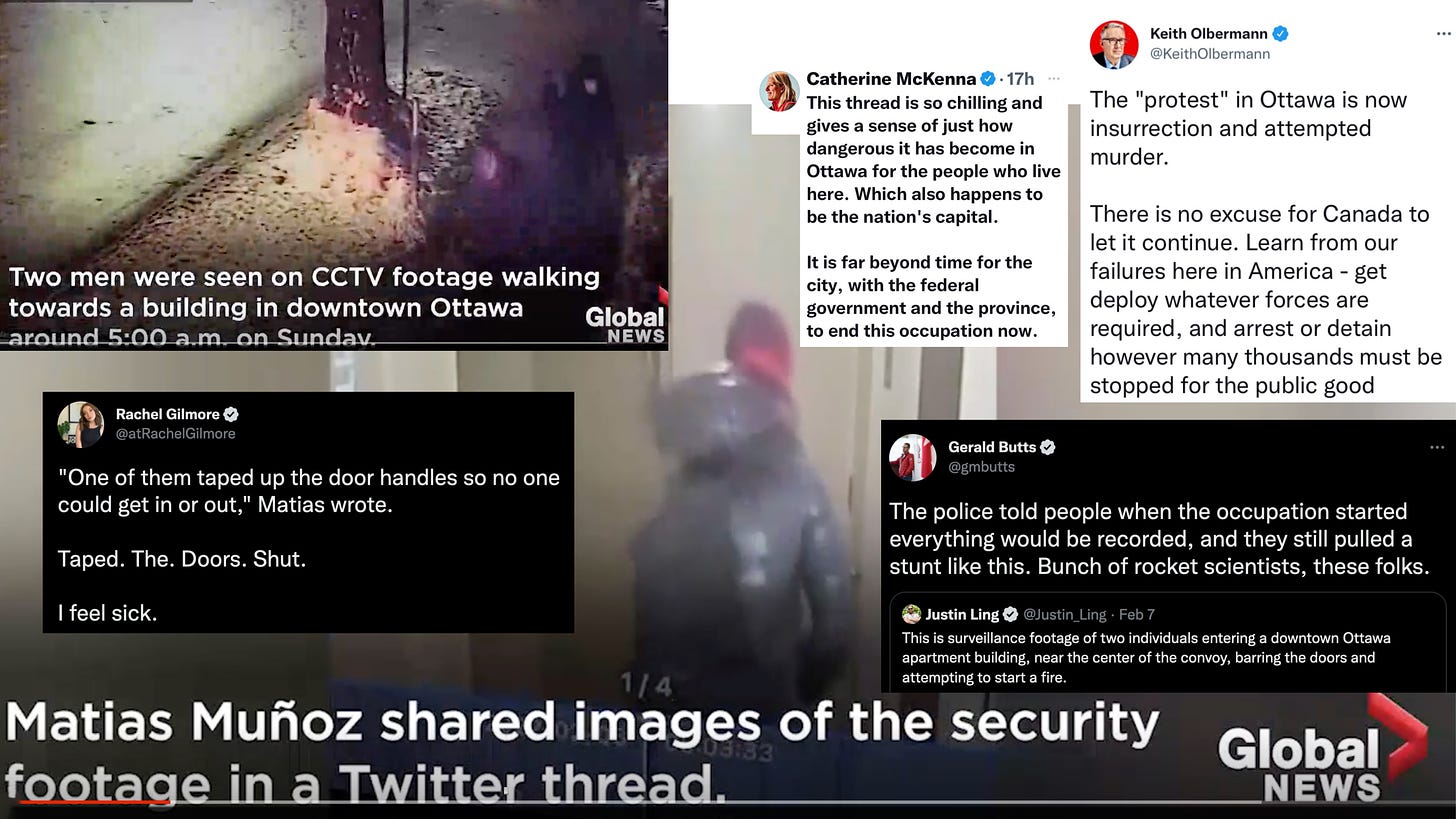How a Fake Arson Narrative Helped the Liberals Brand the Convoy Protest as a ‘National Emergency’
The commission investigating Trudeau’s use of the Emergencies Act should also study the misinformation campaign that preceded it.
For those following the ongoing inquiry into Justin Trudeau’s February 14 decision to invoke the Emergencies Act, this National Post column by law professor Ryan Alford makes for an interesting read. As Alford notes, Trudeau never had any proper basis to cast the protesters as a terrorist group or violent political insurgency (which are the type of “national emergency” threats that the Emergencies Act and its predecessor legislation had been designed to address). So instead, “the government appears prepared to fall back on the position that the protesters simply made it more likely that a ‘lone wolf’ would use the protests as a cover for [violent] actions.”
After citing Ontario Provincial Police Superintendent Pat Morris to the effect that the OPP intelligence unit had no evidence that the Freedom Convoy posed any direct threat to national security, Alford properly concludes: “Every protest increases this inherently unpredictable and unavoidable risk [of a lone-wolf actor]. Eliminating the right to protest on that basis would be as preposterous as banning books owing to the violence that followed the publication of The Satanic Verses” (my emphasis).


The Public Order Emergency Commission has a mandate to “examine and assess the basis for the Government’s decision to declare a public order emergency, the circumstances that led to the declaration, and the appropriateness and effectiveness of the measures selected by the Government to deal with the then-existing situation.” While Commissioner Paul Rouleau is properly focusing primarily on government actors and the protesters themselves, it’s impossible to understand Trudeau’s frame of mind without examining the media environment surrounding his decision, and the hysterical misinformation that suffused it.
Of the numerous media subplots that unfolded during this period, none were more tragicomic than that surrounding Matias Muñoz—the downtown Ottawa appartment dweller who, on February 6, published a harrowing Twitter thread in which he described a pair of self-identified convoy-protesters-turned-arsonists entering his building, taping up the door handles in the lobby, and then trying to burn the whole place down in a pyromaniac act of mass murder.
Muñoz’s thread went viral. And by the time I saw it later that same day, it had already attracted thousands of retweets, quote tweets, and likes, including from legions of mainstream politicians and journalists. Muñoz’s account, many seemed to believe, finally provided the world with proof of what they’d long known in their hearts: that these so-called anti-vaccine-mandate protesters were nothing but vicious thugs who’d stoop to any level—even murder—to terrorize ordinary Canadians.
What’s shocking about the whole episode is how obvious Muñoz’s hoax had been from the get-go. Yes, someone had made some sort of amateurish dorm-room effort to start a fire in the lobby of Muñoz’s building. But in his lengthy Twitter thread (which has since been deleted, along with his entire account), Muñoz added all sorts of bizarre details (which I catalogued that same evening). These included the claim that the arsonists—who looked a lot more like Antifa members than truckers—had freely proclaimed their identity as convoy protesters to a random passer-by, before then continuing with their arson plot. Muñoz also asked us to believe that building residents who’d discovered this evil plan then retired for the night, without calling 911 until well into daylight hours, despite knowing that the building they inhabited was about to go up in flames.
And then—surprise, surprise—the men arrested by Ottawa police in connection with the fire had absolutely nothing to do with the protests. Muñoz had made it all up.


Muñoz himself, a guy who’d once run a local indie music and arts space, isn’t really an important figure here. In fact, it’s possible to have a measure of sympathy for him given that his operation had reportedly been driven out of business by the COVID pandemic. The figures who come off far less sympathetically are the many prominent Canadians who breathlessly amplified his claims without spending the three seconds of reflection required to notice that his story made no sense whatsoever.
Then-Ottawa mayor Jim Watson claimed that the episode “clearly demonstrates the malicious intent” of the truckers’ convoy.” Global News TikTok host Rachel Gilmore breathlessly quote-tweeted Muñoz’s hoax thread, claiming that the “horrifying” “what-ifs” left her feeling “sick.” Gilmore’s Global colleague Amanda Connolly called the story “bone-chillingly horrifying.”


NDP leader Jagmeet Singh (signal-boosted by members of his caucus, including Charlie Angus and Nahanni Fontaine) cited Muñoz’s fantasy narrative as proof that the protesters wanted to “overthrow the government.” CBC Radio put Muñoz on the air. And even as his claims were unravelling, Canadian Press writers Laura Osman and Lee Berthiaume quoted Muñoz at length in their report (as well as throwing in then-mayor Wilson’s credulous affirmation). Even a month and half later, long after the Ottawa police had already confirmed that the suspects in the case had no connection with the protests, Osman was still at it, treating Muñoz as a credible source while doing her best to somehow connect the crime to protestors: “Politicians and police officials have acknowledged that the protest led to a sense of lawlessness in downtown Ottawa at the time, as officers were diverted to Parliament Hill and bylaws went unenforced elsewhere in the core.”
Journalist Warren Kinsella claimed that he knew of children in the building who would attest to the truth of Muñoz’s account, and called it “attempted mass murder.” Also fooled were National Observer lead columnist Max Fawcett, CBC reporter David Cochrane (“I’ve never seen anything like this in my life”), former Green Party leader Elizabeth May, and Alberta Today’s Catherine Griwkowsky. Gerald Butts, who’d formerly served as Trudeau’s right-hand man before being forced to resign in a 2019 scandal (and who later became infamous for celebrating the doxxing of convoy donors), Tweeted that Muñoz’s claims proved the protesters were not only malevolent but also stupid.


Another well-known Liberal, former Minister of Environment and Climate Change Catherine McKenna, foreshadowed Trudeau’s draconian response to the protest with the claim that Muñoz’s “thread is so chilling…It is far beyond time for the city, with the federal government and the province, to end this occupation now.” Liberal MPs echoing such claims included Yasir Naqvi and Ryan Turnbull.

Then there’s American pundit Keith Olbermann, who told his 1-million Twitter followers that Muñoz had proven that “the ‘protest’ in Ottawa is now insurrection and attempted murder. There is no excuse for Canada to let it continue. Learn from our failures here in America…Deploy whatever forces are required, and arrest or detain however many thousands must be stopped for the public good.” I have no idea whether Trudeau ever saw that Tweet (or any of the others I’ve cited). But in any event, eight days after Olbermann’s Tweet appeared, Trudeau ended up following his listed instructions to a T. After all, his own Liberals had been spreading the message that the convoy could prove to be Canada’s equivalent of “Charlottesville or the January 6 insurrection,” even before Muñoz started writing his action-movie script. So the PM probably figured the move would make him a hero.

Back in January and February, I wrote a lot about the convoy protests. And everywhere my columns appeared—including the Washington Post, National Post, Wall Street Journal, and Quillette—I made it abundantly clear that I never supported the protesters’ cause. When it comes to public heath, I’m an utterly conventional quadruple-vaxed Canadian do-gooder (with the ratio to prove it!). Hell, I even enjoy using that crappy ArriveCan app everyone hates. But to quote the headline on my Quillette piece, while “the Ottawa trucker protest was disruptive, the hysterical reaction to it was worse.”

It was worse because it set a legal precedent that future governments will use to quash any kind of protest—whether by Indigenous-rights activists, environmentalists, or small-government conservatives.
It was worse because of the mask-off way it demonstrated the utter contempt in which Canada’s talking heads hold working-class people who dissent on matters of received wisdom (never more so than with one Globe & Mail columnist’s claim, on CBC national television naturally, that the protesters were nothing but “anti-social yobs with delusions of grandeur”).
And it was worse because it confirmed that many of the leading merchants in our marketplace of ideas—the very same figures who haughtily lecture us mere yobs about the need for name-brand news oultets that can steer us away from seductive misinformation—are so addled by bias that they may be taken in by a demonstrably absurd fable spun out of an Ottawa apartment by a local music promoter.
In a recent editorial, the Globe & Mail scolded Conservative leader Pierre Poilievre over his ongoing boycott of Parliament Hill journalists. As the Globe editorial board sees it, Poilievre’s hostility to the media is all about “inventing enemies and playing the role of their victim,” so as to rally supporters and get them to “open their wallets.” And there is a larger principle at stake, we are told: “A free press is a critical part of a healthy liberal democracy, and politicians need to do their part, like it or not.”
These are fair points. And on balance, I tend to agree that Poilievre should start talking to the press. But it’s hardly irrational for any conservative Canadian, whether a politician or otherwise, to regard recent events as proof that when facts and narrative diverge in Canadian newsrooms, it’s the narrative that takes precedence. And so why talk to journalists who’ve clearly already made up their minds, and are busily scouring Twitter for a lively human-interest tale that backs up their point of view?
It’s great that the Public Order Emergency Commission is applying sunlight to the machinations that led Justin Trudeau to invoke the Emergencies Act. But the PM had numerous enablers, without whom he likely woudn’t have acted as he did. And it would be a shame if their role in this mess were not duly acknolwedged when the commission produces its final report.








Unfortunately, this whole public inquiry will be for naught as invocation of the Emergency Act has no consequences for the Govt that invokes it. The EA fiasco, IMO, will ultimately come out via the sands of time, probably as a calculated political wedge that looked to be a good bet with little consequences attached.
"...... [whistling with hands in pockets] ....."
--- Most Canadian media